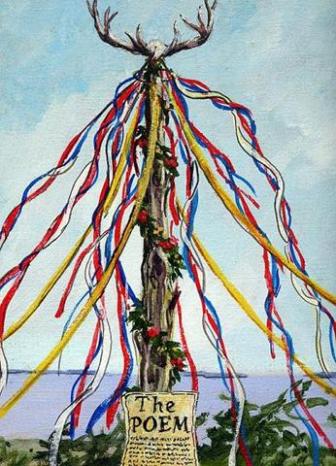Today I have the first of two reviews of non-fiction accounts by colonists in what is now Massachusetts. I’m going to talk about The New English Canaan by Thomas Morton today and A Narrative of Captivity by Mary Rowlandson later. They offer two very different perspectives on British colonists’ interaction with Native Americans. Both accounts were very popular when they were published. I can imagine that Brits wanted to hear about their countrymen who were living in the wilderness with “savages.”
The New English Canaan by Thomas Morton.
Morton is a fascinating figure. He was a member of the gentry, but had a passion for social reform and, well, lawlessness. He came over in 1623 with a Captain Wollaston to establish a settlement, Mount Wollaston, and trade furs with the Algonquin Indians. Morton led the indentured servants in a rebellion against Captain Wollaston and established himself as the head of a new society, which he named Merrymount.
Morton quickly fell out with his neighbors, the Puritans. They hated him. People apparently continued to hate him quite some time. In 1858 a historian in Boston published a reprint of The New English Canaan. In his introduction he calls Morton a “vulgar Royalist libertine” and a dangerous criminal who recklessly sold guns to the Indians. Can you see why the Puritans didn’t like him? In William Bradford’s account Of Plymouth Plantation, Bradford relates that every once in a while people started to feel cheerful, because they had lived through the winter or someone had moved to the colony who knew how to make shoes. On these occasions Bradford had to redouble his anti-dancing efforts to restore a godly state of sobriety in the settlement. By contrast, Morton was a drinker and a reveler. He set up maypoles and held bacchanals. Really. He got drunk and worshipped pagan gods right next door to the Puritans. There were rumors that the settlers consorted with native women.
The Puritans were of course shocked and appalled. Myles Standish, famous Mayflower passenger and massacre-er of Indians, stormed Merrymount, chopped down the 80 foot maypole and arrested Morton. Morton tried to defend his little utopia, but he was too drunk. The Pilgrims stranded him on an island to wait for a ship to take him back to England. He would have starved there if his Indian friends hadn’t regularly brought food over for him. He eventually did get back to England, only to return to Merrymount, get arrested again and sent back to England. Morton really had an axe to grind with the Puritans now, so he sued them for some blah blah blah involving their charter. Morton won the case and had their charter revoked, in large part because King Charles I also disliked the Puritans, those seditious gits. Morton’s capitalist approach to settling the New World was much more profitable to the Crown than the Puritans’ somber collectivism. Side note: they tried communism at Plymouth plantation, but abandoned it, because people just didn’t work as hard or grow as much corn when the fruit of their labor was taken away and redistributed.
Anyway, Morton published The New English Canaan and became a political sensation. In the book he describes the flora and fauna of the New World, which he thinks is essentially paradise. He talks about his interactions with the Puritans and the Indians. Hates the Puritans, thinks the Indians are much nicer people. He finishes up by describing his legal battle. Despite the risk, Morton returned to the colonies and ended up dying in jail there. I found all this incredibly interesting, but I can’t say that I recommend the book. It’s a bit dry and so obscure that the only available texts I could find were garbled e-reader versions.
My favorite component of Morton’s account is his delightfully inaccurate facts about Native Americans and the natural world. Morton informs us that:
- Native American babies are born with a complexion as white as an English baby. Their mothers stain their skin forever by bathing them in walnut husks and leaves.
- The beaver “sits with his tail hanging in the water, which else would over heat and rot off.”
Who knew?


Pingback: The Book List « sydneyreadseverything
If you like these primary memoirs (?) you should read The Narrative of Cabeza De Vaca, by Alvar Nunez. It’s by Spanish dude who tried to do something in Florida, got captured and enslaved by Native Americans, then escaped and walked naked all the way to Mexico. I couldn’t finish it, on account of the dryness, but you could and tell us about it!
Haha! I don’t feel obliged to because it’s in translation and I’m not reading anything in translation for this project. You could cowgirl up, finish it and write a guest post. That would be cool.
Does sound pretty cool.